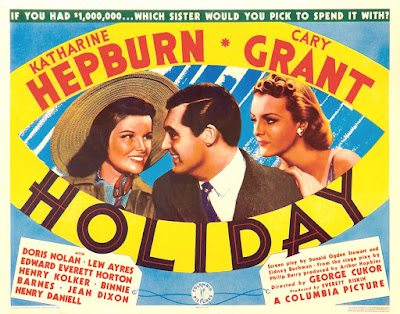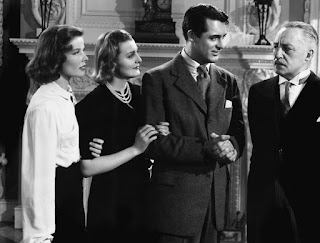 ‘The Criterion Collection’ have recently released a digitally enhanced version of ‘Holiday’. It was directed by George Cukor; it starred Katharine Hepburn, Cary Grant, Lew Ayres, and Doris Nolan; and it lasts for 95-minutes. Plus, as an extra added bonus, the Blu-ray edition comes with a costume gallery, an oral history by the AFI featuring Cukor, the 1930’s version of this film directed by Edward H. Griffith, as well as a conversation between the filmmaker, Michael Schlesinger, and the film critic, Michael Sragow. Please enjoy.
‘The Criterion Collection’ have recently released a digitally enhanced version of ‘Holiday’. It was directed by George Cukor; it starred Katharine Hepburn, Cary Grant, Lew Ayres, and Doris Nolan; and it lasts for 95-minutes. Plus, as an extra added bonus, the Blu-ray edition comes with a costume gallery, an oral history by the AFI featuring Cukor, the 1930’s version of this film directed by Edward H. Griffith, as well as a conversation between the filmmaker, Michael Schlesinger, and the film critic, Michael Sragow. Please enjoy. Holiday (Criterion Collection)
THE STORY:
When my lovely fiancée Julia (Doris Nolan) first introduced me to her family, her very rich family, I wasn’t entirely sure if they would accept me or not. After all, her brother Ned (Lew Ayres) is a diligent drunk, her sister Linda (Katharine Hepburn) is a resourceful recluse, and her father Edward (Henry Kolker) is a controlling conservative, while I‘m just a regular guy living a regular life.
But if truth be told, I needn’t have worried, no, not really, because in no time at all they gradually warmed up to me, one, by one, by one, until we started to talk about finance, status, and priorities, which resulted in a split during our engagement party. A split where Julia and her Dad said they cared more for cash than living life, while the rest of us said we cared more for living life than collecting cash.
Either way, that’s most probably why what next transpires goes, ding-a-ling-a-ling, when I suddenly say to myself, ‘Johnny (Cary Grant)? Am I in love with the wrong sister?’. As a rich family doesn’t know what to do – a working-class lad hasn’t got a clue – a loving couple has an opposing point of view – and at the end of the day, please remember, true love has nothing to do with putting on the correct shoe.
THE REVIEW:
Before we begin, please allow me to place this film within its historical context. Originally, ‘Holiday’ was a stage play written by Philip Barry during a time in American history (1928) where the country was fairly rich and the financial markets were fairly stable. So much so, in fact, that a certain portion of society decided to embrace the bohemian lifestyle we now commonly associate with the 1960s. A lifestyle where they had the time, the resources, and the inclination to ‘drop out of the rat race’ to travel the world and live life, rather than allowing life to live them. But then, in October, 1929, the Wall Street Crash happened, Ka-Boom!, which resulted in many major companies losing millions and millions of dollars. Heck, it affected America so much, that it took over four years for the Dow to regain its footing again and for people to feel stable.
So, as you can see, Philip’s story was initially devised during a fairly prosperous period in history where most people had a different set of priorities. Or to be more specific about it, two sets of priorities. One focused on favoring finance over fun, as it allowed them the opportunity to make money and invest, invest, invest. While the other, favored fun over finance, as it granted people the luxury to feel and experience those things money can’t buy. Things like love, passion, and to some extent, practical knowledge as opposed to academic advice. Similar, in fact, to the type of knowledge I obtained while watching this cinematic adaptation.
Well, not only did I learn the usual stuff you’d normally expect to see in a satirical film about High Society, stuff about cash, class, and curmudgeons, but in addition to this, I also learned about family. Namely, the Seton family, who are four lost souls that each have their own particular problems to deal with. First, there’s Ned Seton, the youngest son, who drinks too much due to his creativity being discouraged by his family obligations. Then there’s Linda, the oldest daughter, who doesn’t seem to have much confidence because she’s continually being overruled by those around her. Julia, on the other hand, is the middle child, and as such, is both kind and confused, depending on the situation. And last, but not least, there’s the head of the household, Edward Seton, who’s a wealthy widower and the main driving force behind this film.
Well, from a narrative point of view, a large portion of the plot revolves around an argument between two men. Julia’s new fiancé, Johnny Case, being one of them, because he wants to take a break from the 9 to 5 in order to experience life while he's still young (late 20s). While the other is Julia’s father, Edward, because he doesn’t like the sound of this at all, even though Johnny says that he will start working again when he’s slightly older.
So, out of the two, who do you think has a more informed outlook on life? Is it Edward, perhaps? Keeping in mind that his daughter hasn’t known Johnny for very long and he could be after her cash! Or is it Johnny? On account of him acquiring his own small fortune and refusing to be controlled by Julia's father. Personally, I’m not entirely sure who's right and who's wrong. No, not really. But I do know that I loved watching this film as it made me think, it made me laugh, and it made me question which sister I'd fancy if I were in Johnny's shoes (Hint: It's not Julia). It also made me realize that we should never judge an era at face value. Otherwise, we would never be able to recognize the true evolution of society and acknowledge how the more things change, the more they stay the same.
Anyway, that's enough of that for the time being, because I think now is a pretty good time for us to sit back, relax, and check out the following filmic facts: (1) ‘Columbia’ first released this production in Los Angeles, California, on the exact same day Tommy Chong from ‘Cheech and Chong’ was born. It was on the 24th of May, 1938. (2) The stage version of this film first opened at the ‘Plymouth Theatre’ in New York City on the 26th of November, 1928, and eventually closed in June, 1929, after 229 performances. (3) Before it was screened in cinemas, this project was given two working titles, ‘Unconventional Linda’ and ‘Vacation Bound’. (4) One of the taglines used to promote this picture, states, ‘If you had a million... which sister would you pick to spend it with?’. (5) The majority of this movie was shot inside ‘Columbia Studios’, located at Sunset Boulevard & Gower Street, Hollywood, California, although a couple of establishing shots were also taken in Manhattan, New York City. (6) According to Philip Barry, Linda Seton was loosely based on Gertrude Sanford Legendre, who was a former debutante that left High Society to become a big-game hunter and a spy for the OSS during World War 2. (7) This wasn’t the first time this particular story was adapted for the silver screen, because in 1930, 'Pathé Exchange' produced a version which starred Ann Harding, Mary Astor, Edward Everett Horton, Robert Ames, and Hedda Hopper. (8) During pre-production, Joan Bennett and Ginger Rogers were considered to play the part of Linda Seton, while Rita Hayworth was considered to play the part of Julia Seton.
In closing my review of ‘Holiday’, I’m now going to rank each key performance in order of preference. So, at the top of my list, I’d like to select the stars of the show, Katharine Hepburn and Cary Grant, because Katharine was quirky, classy, and charismatic with her depiction of Linda Seton, whereas Cary was charming, comedic, and quick on his feet with his portrayal of Johnny Case (particularly during those scenes where he performed a number of acrobatic routines). Up next, I’d like to single out the remaining members of the Seton family. Most notably, Lew Ayres, for playing Ned Seton as a damaged but delightful drunk; Doris Nolan, for playing Julia Seton as a mixture of lovely and frosty; and Henry Kolker, for playing Edward Seton as a controlling yet calm conservative. In addition to this, a special shout out has to go to Edward Everett Horton and Jean Dixon for playing ‘The Potters’ with a nice balance of zany and natural. A balance that complimented the style of this film which was one part dramatic and one part comedic.
Actually, while I’m on the subject of this film’s style, I best mention how everything seen on screen was able to enhance the overall narrative. After all, this is a film about rich people, really rich people, so it only makes sense that the grand hallways, the plush elevators, and the elegant living rooms were all nicely decorated with a mixture of Art Deco fixtures and mahogany furnishings. Likewise, some of the more homely sets, such as ‘The Playroom’, for instance, were also appropriately decorated so they’d appear less grandiose and more intimate in tone. In many ways, these aesthetic garnishes gave this story a sense of validity in terms of how certain characters should feel or behave, depending on their surroundings. Well, whenever someone was in a large hallway or banqueting suite, immediately, they seemed small and benign in comparison. And when they entered a regular-sized room, yes, the opposite was true.
Anyway, all that aside, and I just want to say that this film is a wonderful film, and I would highly recommend it to fans of Hepburn and Grant, romance and comedy, as well as High Society and common dilemmas.
THE RATING: B
HOLIDAY (1938)
 Reviewed by David Andrews
on
January 13, 2020
Rating:
Reviewed by David Andrews
on
January 13, 2020
Rating:
 Reviewed by David Andrews
on
January 13, 2020
Rating:
Reviewed by David Andrews
on
January 13, 2020
Rating:












No comments: